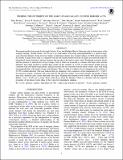PROBING THE OUTSKIRTS OF THE EARLY-STAGE GALAXY CLUSTER MERGER A1750
Author(s)
Bulbul, Esra; Randall, Scott W.; Bayliss, Matthew; Miller, Eric; Andrade-Santos, Felipe; Johnson, Ryan; Blanton, Elizabeth L.; Forman, William R.; Jones, Christine; Paterno-Mahler, Rachel; Murray, Stephen S.; Sarazin, Craig L.; Smith, Randall K.; Ezer, Cemile; Miller, Eric D; Bautz, Marshall W.; ... Show more Show less
DownloadBulbul_2016_ApJ_818_131.pdf (2.385Mb)
PUBLISHER_POLICY
Publisher Policy
Article is made available in accordance with the publisher's policy and may be subject to US copyright law. Please refer to the publisher's site for terms of use.
Terms of use
Metadata
Show full item recordAbstract
We present results from recent Suzaku and Chandra X-ray and Multiple Mirrior Telescope optical observations of the strongly merging "double cluster" A1750 out to its virial radius, both along and perpendicular to a putative large-scale structure filament. Some previous studies of individual clusters have found evidence for ICM entropy profiles that flatten at large cluster radii, as compared with the self-similar prediction based on purely gravitational models of hierarchical cluster formation, and gas fractions that rise above the mean cosmic value. Weakening accretion shocks and the presence of unresolved cool gas clumps, both of which are expected to correlate with large-scale structure filaments, have been invoked to explain these results. In the outskirts of A1750, we find entropy profiles that are consistent with self-similar expectations, and gas fractions that are consistent with the mean cosmic value, both along and perpendicular to the putative large-scale filament. Thus, we find no evidence for gas clumping in the outskirts of A1750, in either direction. This may indicate that gas clumping is less common in lower temperature (kT ap; 4 keV), less massive systems, consistent with some (but not all) previous studies of low-mass clusters and groups. Cluster mass may, therefore, play a more important role in gas clumping than dynamical state. Finally, we find evidence for diffuse, cool ( < 1 keV) gas at large cluster radii (R 200 ) along the filament, which is consistent with the expected properties of the denser, hotter phase of the warm-hot intergalactic medium. Key words: galaxies: clusters: individual (A1750); large-scale structure of universe; X-rays: galaxies: clusters
Date issued
2016-02Department
Massachusetts Institute of Technology. Department of Physics; MIT Kavli Institute for Astrophysics and Space ResearchJournal
Astrophysical Journal
Publisher
American Astronomical Society/IOP Publishing
Citation
Bulbul, Esra et al. “PROBING THE OUTSKIRTS OF THE EARLY-STAGE GALAXY CLUSTER MERGER A1750.” The Astrophysical Journal 818, 2 (February 2016): 131 © 2016 The American Astronomical Society
Version: Final published version
ISSN
1538-4357
0004-637X